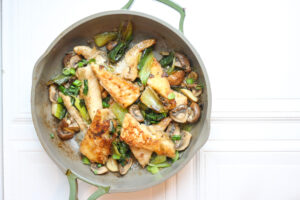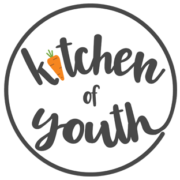Crispy Tofu And Vegetable Stir Fry
This Crispy Tofu And Vegetable Stir Fry is the perfect simple and healthy vegan dinner. I know you’ll love it.

Crispy Tofu is probably the only way I eat tofu. I just don’t like it mushy. I used to think the only way to get it crispy enough was in the air fryer. And while air frying is easy, my air fryer just isn’t large enough to make as much as I want for a dish like this at one time. And I hate having to repeat the process more than once. My need for immediate gratification isn’t satisfied that way.
Enter… this recipe for Crispy Tofu and Vegetable Stir Fry. It’s all made on top of the stove. In the same pan. The tofu is really crispy. The veggies are really tender and flavorful. Well, it’s really just awesome. And, as an added benefit, it holds up really well in the fridge for a few days. I like to put the whole pan in the fridge, covered, and then just reheat on the stove.
I’m embarrassed to say that for many years I avoided tofu. All of the conflicting info about it being good or bad or bad for women or bad for menopausal women… it was just a mess. I’ve done my own research and now I do use soy products as long as they are unadulterated and organic. I’m still not a fan of soy milk, but give me a good block or organic tofu or some fermented soy products like tempeh and I’m happy.
I first saw this recipe on a great blog: Dinner A Love Story. Since then, I’ve made this recipe a few times and I’ve changed it up a bit to suit my needs. It’s one of the great things about this dish… it can be customized to your liking. You can use whatever veggies you like. You can make it spicy. Or not. You do you.

Here are some of the great healing ingredients in this Crispy Tofu And Vegetable Stir Fry recipe:
Tofu is touted in Chinese medicine for its ability to help detoxify the body. It also can help you with energy and with dryness in the body. NOTE: many people don’t do well with a lot of foods that are cold in property, and tofu is cold. So, don’t eat too much if you fall into this category.
Garlic is amazing in its antiviral and antibacterial capabilities. Garlic is actually a Chinese herb (Da Suan). It’s used to kill toxins and parasites and also to reduce swelling in the body. It’s what I call a great “A” herb: anesthetic, antibacterial, anti fungal, antioxidant, antiviral, etc….
In Chinese medicine, bok choy is used to quench thirst, aid digestion, prevent constipation and treat diabetes. It is rich in vitamin C, beta-carotene, folate and fiber. And there are only 20 calories in one cup of Bok Choy. So, it’s good for you, it’s easy to prepare, and it tastes good.
In Chinese medicine, mushrooms ARE medicine. They are herbs. They are one of the most healing foods around. In China, mushrooms have been used for many years as part of a natural cancer treatment. They are one of the best immune-boosting foods around. I used shiitakes in this recipe. Shiitake mushrooms are probably the variety of mushroom that I use most. I love the way they taste and they help lower blood pressure and cholesterol. These shrooms also promote healing and have been found to fight tumors. In Asia, shiitake mushrooms are often fed to a patient who has just had surgery to help the healing process.


Crispy Tofu And Vegetable Stir Fry
Ingredients
- 1 block extra firm tofu sliced into 1/2-in thick slices, then those slices cut diagonally in half to form large triangles.
- 3 Tbs coconut aminos
- 1/2 cup cornstarch, arrowroot, or tapioca flour
- 3 Tbs avocado oil
- 3 heads baby bok choy sliced
- 6 oz mushrooms sliced or cut into quarters or halves
- 8 cloves garlic smashed
- 1/2 cup water
Instructions
- Put the tofu in a large shallow dish and drizzle with 1 Tbs of coconut aminos.
- Put the cornstarch in another large shallow dish or pie plate.Carefully lift the tofu slices into the cornstarch, then gently flip them over so they are coated in cornstarch.
- Heat 2 Tbs oil in a large skillet until hot.
- Add the tofu to the skillet and let cook, over medium-high heat until golden on the bottom, then carefully flip and cook until golden on the other side. Remove tofu to a plate.
- Add more oil to the pan if necessary and add the bok choy. Stir, for 1 min.
- Add mushroom and garlic and stir for about 2 mins or until softened a bit.
- Pour in 1/2 cup water and stir until combined.
- Add tofu back into pan and let simmer, on low heat, until the sauce is thickened a bit.
- Serve as is in the pot, or arrange on individual plates. Enjoy!





